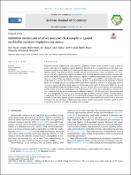Options
Inhibition Mechanism Of Silver Nanoparticle-kaempferol Against Methicillin-resistant Staphylococcus Aureus
Journal
Arabian Journal of Chemistry
ISSN
1878-5352
Date Issued
2024
Author(s)
Nur Farah Atiqah Mohd Pazli
Siti Aisyah Abd Ghafar
Ariff Haikal Hairil Anuar
DOI
10.1016/j.arabjc.2023.105489
Abstract
Methicillin-resistant Staphylococcus aureus (MRSA), a multidrug resistant strain, is known to cause a threat to public health due to its limited therapeutic treatment. Kaempferol (K) is a natural flavonoid that shows antibacterial activities toward MRSA, but its effectiveness is limited due to its low water solubility. However, poorly aqueous soluble drugs displayed better solubility through nano formulation. Hence, kaempferols were incorporated with silver nanoparticles (AgNPs) to enhance their solubility and antibacterial activity. Previous study showed that AgNPs incorporated with kaempferol (AgNPs-K) exhibited antibacterial activity against MRSA. However, the knowledge regarding the mechanism of action AgNPs-K against MRSA is still limited. The objective of the study is to unravel the inhibition mechanism of silver nanoparticles-kaempferol (AgNPs-K) on treated MRSA. The scanning electron microscopy (SEM) result showed significant difference in morphology between
treated and non-treated MRSA which suggest the effectiveness of the AgNPs-K. Non-treated MRSA has an oval shape while MRSA treated with AgNPs-K showed a disrupted cell wall with contents leakage. The transcriptomic profile analysis by Next Generation Sequencing (NGS) showed that various genes and pathways related to biofilm, virulent activity and glycolysis pathway are differently expressed, with 581 genes were downregulated and 641 were upregulated. The affected genes of icab, clfa and eno which involved in biofilm, clumping factor A
(virulent) and glycolysis pathway were validated by RT-PCR technique. The results were consistent with the NGS outcome. In conclusion, AgNPs-K possesses antibacterial activity against MRSA and its mechanism of action are reflected in the gene expression of biofilm pathway, virulent and glycolysis activity. Therefore, AgNPs-K can be suggested as a potential alternative to combat MRSA infection.
treated and non-treated MRSA which suggest the effectiveness of the AgNPs-K. Non-treated MRSA has an oval shape while MRSA treated with AgNPs-K showed a disrupted cell wall with contents leakage. The transcriptomic profile analysis by Next Generation Sequencing (NGS) showed that various genes and pathways related to biofilm, virulent activity and glycolysis pathway are differently expressed, with 581 genes were downregulated and 641 were upregulated. The affected genes of icab, clfa and eno which involved in biofilm, clumping factor A
(virulent) and glycolysis pathway were validated by RT-PCR technique. The results were consistent with the NGS outcome. In conclusion, AgNPs-K possesses antibacterial activity against MRSA and its mechanism of action are reflected in the gene expression of biofilm pathway, virulent and glycolysis activity. Therefore, AgNPs-K can be suggested as a potential alternative to combat MRSA infection.
Subjects
File(s)
Loading...
Name
Inhibition mechanism of silver nanoparticle-kaempferol against methicillin-resistant Staphylococcus aureus
Type
main article
Size
4.63 MB
Format
Adobe PDF
Checksum
(MD5):4d70b876e44894bbc8323653a234842a